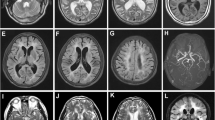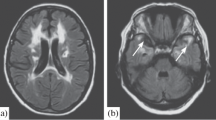Abstract
Cerebral autosomal dominant arteriopathy with subcortical infarcts and leukoencephalopathy (CADASIL) is a genetic disorder caused by mutations in the NOTCH3 gene, with a striking variability in phenotypic expression. To date, only two homozygous patients have been reported, with divergent phenotypic features. We describe an Italian CADASIL patient, homozygous for G528C mutation, in whom early manifestation of the disease was migraine, but whose clinical evolution was characterized by a reversible acute encephalopathy followed by full recovery (“CADASIL coma”). Clinical evaluation, MR scan, neuropsychological and neurophysiological investigation did not reveal substantial differences between our homozygous patient and her heterozygous relatives sharing the same mutation, or between our patient and a group of heterozygous individuals with the same mutation but from different families. Skin biopsy identified peculiar features in the homozygous patient, with cytoplasmic pseudoinclusions likely containing granular osmiophilic material (GOM) in the vascular smooth muscle cells, but further studies are necessary to substantiate their possible relationships with CADASIL homozygosis. “CADASIL coma” did not seem to be specific of patient’s homozygosis, since it was observed in one of her heterozygous relatives, whereas its pathogenesis seems to be related to peculiar constellations of unknown predisposing factors. The present study demonstrated that CADASIL conforms to the classical definition of dominant diseases, according to which homozygotes and heterozygotes for a defect are phenotypically indistinguishable.



Similar content being viewed by others
References
Joutel A, Corpechot C, Ducros A, Vahedi K, Chabriat H, Mouton P, Alamowitch S, Domenga V, Cécillion M, Marechal E, Maciazek J, Vayssiere C, Cruaud C, Cabanis EA, Ruchoux MM, Weissenbach J, Bach JF, Bousser MG, Tournier-Lasserve E (1996) NOTCH3 mutations in CADASIL, a hereditary adult-onset condition causing stroke and dementia. Nature 383:707–710
Chabriat H, Vahedi K, Bousser MG, Iba-Zizen MT, Joutel A, Nibbio A, Nagy TG, Tournier Lasserve E, Krebs MO, Julien J, Ducrocq X, Levasseur M, Mas JL, Dubois B, Homeyer P, Lyon-Caen O (1995) Clinical spectrum of CADASIL: a study of 7 families. Lancet 346:934–939
Dichgans M, Mayer M, Uttner I, Brüning R, Müller-Höcker J, Rungger G, Ebke M, Klockgether T, Gasser T (1998) The phenotypic spectrum of CADASIL: clinical findings in 102 cases. Ann Neurol 44:731–739
Dichgans M (2002) CADASIL: a monogenic condition causing stroke and subcortical vascular dementia. Cerebrovasc Dis 13:37–41
Mawet J, Vahedi K, Aout M, Vicaut E, Duering M, Pj Touboul, Dichgans M, Chabriat H (2011) Carotid atherosclerotic markers in CADASIL. Cerebrovasc Dis 31:246–252
Finsterer J (2007) Neuromuscular implications in CADASIL. Cerebrovasc Dis 24:401–404
Ragno M, Pianese L, Cacchiò G, Manca A, Scarcella M, Silvestri S, Di Marzio F, Caiazzo AR, Silvaggio F, Tasca G, Mirabella M, Trojano L (2012) Multi-organ investigation in 16 CADASIL families from central Italy sharing the same R1006C mutation. Neurosci Lett 506:116–120
Ragno M, Trojano L, Pianese L, Boni MV, Silvestri S, Mambelli V, Lorenzi T, Scarpelli M, Morroni M (2012) Renal involvement in cerebral autosomal dominant arteriopathy with subcortical infarcts and leukoencephalopathy (CADASIL): report of a case with a six-year follow-up. Histol Histopathol 27:1307–1314
Fujiwara Y, Mizuno T, Okuyama C, Nagakane Y, Watanabe-Hosomi A, Kondo M, Kuriyama N, Tokuda T, Matsushima S, Nishimura T, Nakagawa M (2012) Simultaneous impairment of intracranial and peripheral artery vasoreactivity in CADASIL patients. Cerebrovasc Dis 33:128–134
Touminen S, Juvonen V, Amberla K, Jolma T, Rinne JO, Tuisku S, Kurki T, Marttila R, Pöyhönen M, Savontaus ML, Viitanen M, Kalimo H (2001) Phenotype of a homozygous CADASIL patient in comparison to 9 age-matched heterozygous patients with the same R133C NOTCH3 mutation. Stroke 32:1767–1774
Liem MK, Lesnik Oberstein SA, Vollebregt MJ, Middelkoop HA, van der Grond J, Helderman-van den Enden AT (2008) Homozygosity for a NOTCH3 mutation in a 65-year-old CADASIL patient with mild symptoms: a family report. J Neurol 255(12):1978–1980
Chabriat H, Tournier-Lasserve E, Vahedi K, Leys D, Joutel A, Nibbio A, Escaillas JP, Iba-Zizen MT, Bracard S, Tehindrazanarivelo A, Gastaut JL, Bousser MG (1995) Autosomal dominant migraine with MRI white-matter abnormalities mapping to the CADASIL locus. Neurology 45:1086–1091
Feuerhake F, Volk B, Ostertag CB, Jungling FD, Kassubek J, Orszagh M, Dichgans M (2002) Reversible coma with raised intracranial pressure: an unusual clinical manifestation of CADASIL. Acta Neuropathol 103:188–192
Schon F, Martin RJ, Prevett M, Clough C, Enevoldson TP, Markus HS (2003) “CADASIL coma”: an underdiagnosed acute encephalopathy. J Neurol Neurosurg Psychiatry 74:249–252
Adib-Samii P, Brice G, Martin RJ, Markus HS (2010) Clinical spectrum of CADASIL and the effect of cardiovascular risk factors on phenotype: study in 200 consecutively recruited individuals. Stroke 41(4):630–634
Van Swieten JC, Koudstaal PJ, Visser MC, Schouten HJ, van Gijn J (1988) Interobserver agreement for the assessment of handicap in stroke patients. Stroke 19:604–607
Measso G, Cavarzeran F, Zappala G, Crook TH, Romani L, Pirozzolo FJ, Grigoletto F, Amaducci LA, Massari D, Lebowitz BD (1993) The mini-mental state examination: normative study of an Italian random sample. Develop Neuropsychol 9:77–85
Scheltens P, Barkhof F, Leys D, Pruvo JP, Nauta JJ, Vermersch P, Steinling M, Valk J (1993) A semiquantitative rating scale for the assessment of signal hyperintensities on magnetic resonance imaging. J Neurol Sci 114:7–12
Cappelli A, Ragno M, Cacchiò G, Scarcella M, Staffolani P, Pianese L (2009) High recurrence of the R1006C NOTCH3 mutation in central Italian patients with cerebral autosomal dominant arteriopathy with subcortical infarcts and leukoencephalopathy (CADASIL). Neurosci Lett 462:176–178
Crawford JR, Garthwaite PH (2002) Investigation of the single case in neuropsychology: confidence limits on the abnormality of test scores and test score differences. Neuropsychologia 40:1196–1208
Joutel A, Chabriat H, Vahedi K, Domenga V, Vayssière C, Ruchoux MM, Lucas C, Leys D, Bousser MG, Tournier-Lasserve E (2000) Splice site mutation causing a seven aminoacid NOTCH3 in-frame deletion in CADASIL. Neurology 54:1874–1875
Chabriat H, Joutel A, Dichgans M, Tournier-Lasserve E, Bousser MG (2009) Cadasil. Lancet Neurol 8:643–653
Headache Classification Subcommittee of the International Headache Society (2004) The International Classification of Headache Disorders: 2nd edition. Cephalalgia 24(Suppl 1):S1–S160
Acknowledgments
This study was supported by a research agreement between the Asur Marche area Vasta n. 5, Ascoli Piceno and the University of Camerino, Doctoral Course in Environmental Sciences and Public Health.
Conflict of interest
The present research has not been sponsored by any commercial organization. The authors declare that they have no conflict of interest.
Author information
Authors and Affiliations
Corresponding authors
Rights and permissions
About this article
Cite this article
Ragno, M., Pianese, L., Morroni, M. et al. “CADASIL coma” in an Italian homozygous CADASIL patient: comparison with clinical and MRI findings in age-matched heterozygous patients with the same G528C NOTCH3 mutation. Neurol Sci 34, 1947–1953 (2013). https://doi.org/10.1007/s10072-013-1418-5
Received:
Accepted:
Published:
Issue Date:
DOI: https://doi.org/10.1007/s10072-013-1418-5




